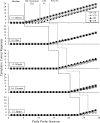The Effects of the Interspersal of Related Responses on the Emergence of Intraverbals for Children With Autism Spectrum Disorder
- PMID: 31976229
- PMCID: PMC6877681
- DOI: 10.1007/s40616-019-00110-4
The Effects of the Interspersal of Related Responses on the Emergence of Intraverbals for Children With Autism Spectrum Disorder
Abstract
The present study evaluated the emergence of intraverbals for 2 children diagnosed with autism spectrum disorder. Prior to baseline, both children demonstrated tact, tact function, listener, and listener by function responses with 12 pictorial stimuli, yet they failed to demonstrate intraverbals related to the function of the items (e.g., "What do you do with [item]?" and "What do you use to [function]?"). Following baseline, previously mastered related tact, tact function, listener, and listener by function tasks were presented prior to probe trials for the target item-function and function-item intraverbals. Results showed that interspersal of the related tasks for a subset of the intraverbals led to the emergence of untrained item-function and function-item intraverbals for both participants. In Experiment 2, the long-term effects of this remedial training on the emergence of untrained intraverbals was evaluated as new tact and listener responses were trained. Results of Experiment 2 showed that tact function and listener by function training was sufficient to establish the emergence of item-function and function-item intraverbals in the absence of related-task interspersal. These results are discussed in relation to current explanations for emergent responding.
Keywords: autism; emergence; intraverbal; listener responding; tact; verbal behavior.
© Association for Behavior Analysis International 2019.
Conflict of interest statement
Conflict of InterestThe authors have no declared financial conflicts of interest.
Figures



Similar articles
-
Teaching a small foreign language vocabulary to children using tact and listener instruction with a prompt delay.J Appl Behav Anal. 2022 Feb;55(1):249-263. doi: 10.1002/jaba.885. Epub 2021 Oct 15. J Appl Behav Anal. 2022. PMID: 34651700
-
Learning a foreign language: Effects of tact and listener instruction on the emergence of bidirectional intraverbals.J Appl Behav Anal. 2020 Jan;53(1):484-492. doi: 10.1002/jaba.559. Epub 2019 Mar 29. J Appl Behav Anal. 2020. PMID: 30924145
-
Evaluating the Emergence of Reverse Intraverbals in Children with Autism.Anal Verbal Behav. 2014 Nov 21;31(1):59-75. doi: 10.1007/s40616-014-0025-8. eCollection 2015 Jun. Anal Verbal Behav. 2014. PMID: 27606199 Free PMC article.
-
The Effects of Auditory Tact and Auditory Imagining Instructions on the Emergence of Novel Intraverbals.Anal Verbal Behav. 2015 Sep 3;31(2):236-54. doi: 10.1007/s40616-015-0036-0. eCollection 2015 Oct. Anal Verbal Behav. 2015. PMID: 27606214 Free PMC article.
-
A Systematic Review of Emergent Learning Outcomes Produced by Foreign language Tact Training.Anal Verbal Behav. 2022 Jul 6;38(2):157-178. doi: 10.1007/s40616-022-00170-z. eCollection 2022 Dec. Anal Verbal Behav. 2022. PMID: 36605418 Free PMC article. Review.
Cited by
-
The Impact of an Intraverbal Webbing Procedure on the Emergence of Advanced Intraverbal Skills in Children with Autism Spectrum Disorder.Behav Anal Pract. 2020 Feb 10;13(4):914-923. doi: 10.1007/s40617-020-00410-5. eCollection 2020 Dec. Behav Anal Pract. 2020. PMID: 33269201 Free PMC article.
-
Teaching receptive vocabulary to two autistic children: A replicated, clinic-based, single case experimental design.Autism Dev Lang Impair. 2024 May 27;9:23969415241258699. doi: 10.1177/23969415241258699. eCollection 2024 Jan-Dec. Autism Dev Lang Impair. 2024. PMID: 38808302 Free PMC article.
References
-
- Arntzen E, Hansen S. Training structures and the formation of equivalence classes. European Journal of Behavior Analysis. 2011;12(2):483–503.
-
- Delfs CH, Conine DE, Frampton SE, Shillingsburg MA, Robinson HC. Evaluation of the efficiency of listener and tact instruction for children with autism. Journal of Applied Behavior Analysis. 2014;47(4):793–809. - PubMed
LinkOut - more resources
Full Text Sources

